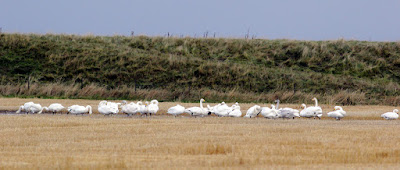There’s rain and wind forecast for several days ahead. Chances were that this morning might be the only weather window for a spot of ringing so I met with Andy at Oakenclough at first light. Heavy cloud greeted us and while for the next fours there was no rain there was also little in the way of visible migration with blocking cloud in all directions.
A quiet session of ringing produced just 19 birds, below par for this site. 6 Goldfinch, 3 Chaffinch, 3 Coal Tit, 2 Siskin, 2 Goldcrest, 1 Blue Tit, 1 Fieldfare and 1 Blackbird.
Visible migration proved to be equally quiet with a single flock of Fieldfares this morning when 50+ birds arrived from the north. Just one first year male found the nets before the pack of thrushes moved quickly through the site and left to the south. Otherwise we saw less than 10 more Fieldfares until midday. After catching about 60 Redwings in the past two weeks the species was conspicuous by its absence this morning with less than 10 seen. Blackbirds were more in evidence with 16+ in the area and a single “Continental” type male finding the net. The two Siskins were both males, one an adult the other a first year.
Fieldfare
Siskin - adult male
Siskin - first year male
Chaffinches and Bramblings were on the move with 70+ Chaffinches over in several small flocks and 3+ Bramblings among them. Luckily the Bramblings made several calls as they arrived with their cousins as otherwise and in the poor light we may not have seen them.
A flock of 40+ Goldfinches were/are local birds with the 6 caught including two recaptures.
Other sightings included a male Sparrowhawk, Great-spotted Woodpecker and Pied Wagtail.
There was visible migration of Woodpigeons with several flocks overhead and travelling rapidly south, about 120 in total. Later as I drove home via Out Rawcliffe I noted several hundred Wood Pigeons feeding in a single stubble field. Also, Buzzard, Sparrowhawk and Kestrel along Lancaster Road at Pilling.
While the forecast rain may limit any ringing for a day or two there will be some birding to report so log in soon for more news and views.
Linking today to Anni's Birding and Eileen's Saturday.
Linking today to Anni's Birding and Eileen's Saturday.




























































